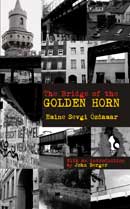

Serpent's Tail, paperback, 9781852429324
The Bridge of the Golden Horn is the story of Turkey and ultimately the story of every struggle, oppression, and revolution. Blood flows. Torture abounds. Revolutionaries are hanged. Streets are filled with the maimed.
Özdamar's novel vividly depicts the dichotomy of all aspects of Turkish life. Istanbul, where most of the action takes place, has an Asian side and a European side. The country is split between the fascists and the communists, who, over the time frame of the novel (1966-1975) wage revolutions, counter-revolutions, and coup d'états. The workers and the intellectuals are always at loggerheads. They work, move, and think at different speeds, with different preoccupations. The novel's protagonist is studying to become an actress, yet her tongue 'divides in two', driven to play an active role in the struggle of the people. 'With one half I said "solidarity with the oppressed peoples"; with the other half of my tongue I spoke lines by Shakespeare.' Her very being is split: she keeps escaping to Berlin to work and study, yet Turkey remains firmly in her heart, always a part of her.
The plot, ultimately, is secondary; the struggle is key. Bertolt Brecht and Alexander Dubcek, with their walk-on roles, are as significant as the unnamed narrator and her lovers Kerim and Jordi. We see the same pattern constantly repeated: revolution, counter-revolution, coup d'état. Students are thrown into prison, they are released, they are executed. The pattern is never-ending; the struggle continues. All sides–fascists, communists, religious zealots–put on the cloak of Ataturk, the founder of modern Turkey. Everyone claims to be his child and follower.
Turkey itself is the heroine of the novel. Of course, decades beyond the period covered by the book, the nation remains in turmoil. In 2005, Orhan Pamuk — the first Turk to win a Nobel Prize — stated that "thirty thousand Kurds have been killed here, and a million Armenians. And almost nobody dares to mention that. So I do." The response of the Turkish government was to press criminal charges against him. Faced with a hate campaign, Pamuk was forced to flee the country, just as our protagonist does. Özdamar shows that in Turkey history is not a matter of the past; it is not at arm's length. History is the present. History is a part of every action.
The bridge of the title remains in the background for most of the novel but does form the final image. This bridge is being dismantled; the seagulls and the train going along it for the last time are crying. No bridging of the conflicts has taken place; the schism is ever present. The ideologies and the people themselves remain unreconciled.
The novel is difficult to read, difficult to put down. The action is brutal, the prose spare.
It is in the end a most memorable portrayal of a riven country.